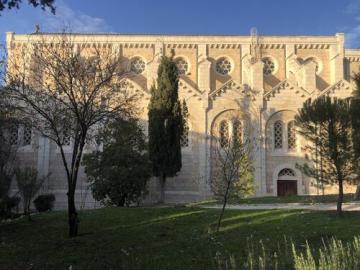Research trip to Convent of Saint-Etienne
Adi Meyerovitch is a doctoral student in the history and theory of architecture at Yale School of Architecture. She studies the history of architecture in the nineteenth and twentieth centuries with an emphasis on the Middle East.
The European Studies Council at the MacMillan Center made it possible for me to travel to Jerusalem in December 2021 in order to conduct research at the École Biblique Archéologique Française in the Convent of Saint-Étienne. In preparation for my dissertation research on the French construction, architectural restoration, and archeological excavation in Jerusalem during the second half of the nineteenth century, the experience proved extremely beneficial.
I visited the École’s photography archive, which was established at the institution’s inception and has grown to become one of the largest photographic collections of Ottoman Palestine. The Archive contains the collection of the École, which consists of approximately 12,000 original glass negatives and 13,000 sheet-films, middle-format negatives, and sepia prints. In addition, there are 2,200 photographs from the nineteenth century taken by the White Fathers at St. Anne’s church, an adjacent French domain in the old city of Jerusalem. Additional 1,600 glass plates were obtained from the Assumptionist Fathers of the former Notre-Dame-de-France convent and other communities (Jesuits, Salesians, Trappists, and Betharramite Fathers). Additionally, the Latin Patriarchate loaned 2,400 photographs from its albums. This enormous, rare collection is digitized and searchable at the archive, but it has not yet been cataloged.
Professor Emeritus Father Jean-Michel de Tarragon, the director of the archive, introduced me to the uncataloged collections and assisted me in navigating them. I was especially pleased to obtain digital copies of rare photographs taken by the White Fathers of the convent of St. Anne during the construction of the complex, which raise questions about the relationship between photographic representations and Ottoman Jerusalem architecture. I also spent time in the library of the École, where the librarian, Father Bernard Didier, helped me locate pertinent literature. I was able to find, among other useful literature, a rare book by Christophe-Edouard Mauss, the architect of the French Ministry of Foreign Affairs and one of the protagonists of my research. Dr. Father Dominique-Marie Cabaret, an École archaeologist whose research focuses on Jerusalem, assisted me in locating additional archival materials and generously shared his knowledge and expertise, allowing me to consider how to better situate my research in its local context. Remarkably, the archive is located near the Old City, where the majority of the sites I am researching are situated. During my stay at the convent, I had the opportunity to visit these sites, including the St. Anne’s Complex. Father Pol Vonck of the St. Anne Monastery graciously gave a tour of the grounds and shared his extensive knowledge of the church and the history of archeological excavations at the site.
